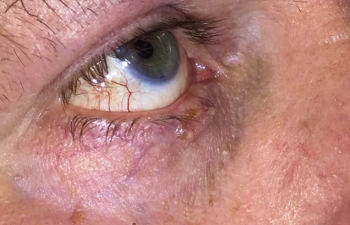
Why is There a Bump on My Eyelid?
Eyelid bumps (also known as lesions) are very common. They can fall into a few different categories. Those that have been there as long as you can remember, bumps that get bigger and then get smaller over a few weeks or months, or ones that slowly grow over months.
If a bump has been there for as long as you can remember – but maybe you’re just becoming more aware of it now – this could be a congenital lesion. Sometimes these are called a nevus, but there are different types. These bumps can be flat, usually along the eyelashes, and sometimes have brown pigment in them. Sometimes these can grow a little bigger during adolescence, but overall they stay about the same size throughout life. For some patients, these can irritate the eye or sometimes even be big enough to be noticeable in the peripheral vision. Patients often elect to have these removed in the office. A congenital nevus on the eyelid can grow back even after removal, sometimes because it was only partially removed, or sometimes because a few cells get left behind that can regrow the lesion over time. Talk to Dr. Eftekhari if you have any questions about this.
Bumps that get bigger and then smaller over a few weeks or months can be a stye (medical term chalazion or hordeolum) – or sometimes an infection or ingrown hair in the area just beneath the eyebrow. These bumps are a nuisance, but may not necessarily be concerning. It’s usually worthwhile to try some hot compresses (link to blepharitis/stye instructions on site) to see if it gets better. If you have concerns, we can take a look in the office to determine if there are signs of an infection. A stye that does not get smaller after about 2 months needs to be looked at by a physician, because sometimes these can actually be a skin cancer that just happens to look like a stye.
Bumps that slowly grow over months can be more concerning. Skin cancer is very common in Utah because of our altitude and sun exposure, and can be especially common on the lower eyelids. There are three main types of skin cancer: basal cell carcinoma, squamous cell carcinoma, and melanoma. If you have a bump on your eyelid that is growing or that you or your primary care doctor are concerned about, call our office to schedule an appointment for a biopsy. A biopsy in our office is done under local anesthesia, takes under 5 minutes, and Dr. Eftekhari takes many precautions to keep you comfortable and as pain-free as possible throughout the process (in the future, link to upcoming post about “what it’s like to get a biopsy of the eyelid in the office”).
If you have any questions or would like to set up an appointment to get your eyelid lesion looked at by our team, please contact us below. With clinics in Salt Lake City, Draper & Park City, Eyelid Center of Utah’s , Dr. Eftekhari is a board-certified ophthalmologist (ABO profile link) and oculofacial plastic surgeon who exclusively specializes in eyelid surgery, and is an active member of the American Society for Ophthalmic Plastic & Reconstructive Surgery (www.asoprs.org).
Posted on behalf of
